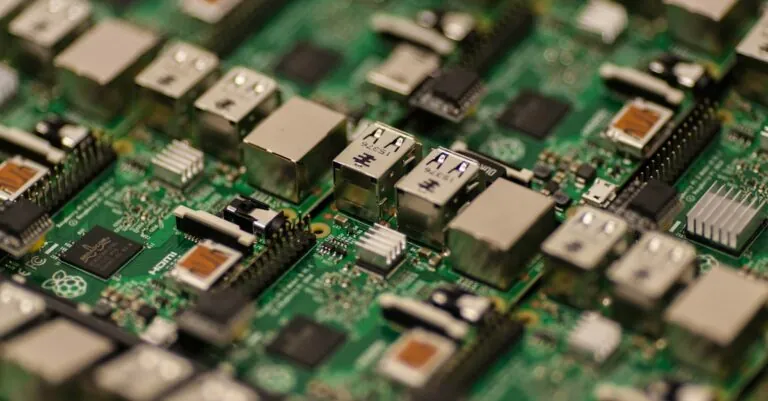Imagine waking up to a world where your coffee brews itself, your thermostat knows just the right temperature, and your fridge reminds you to buy more ice cream. Welcome to the Internet of Things (IoT), where everyday devices transform into smart companions that make life a whole lot easier—and a little more entertaining.
These nifty gadgets aren’t just for tech enthusiasts; they’re for anyone who enjoys convenience with a dash of humor. From smart light bulbs that can dance to your favorite tunes to fitness trackers that remind you to move (even when you’d rather binge-watch your favorite show), IoT devices are revolutionizing how we live, work, and play. Dive into the world of IoT and discover how these devices can turn your home into a smart haven, one quirky gadget at a time.
Table of Contents
ToggleOverview of The Internet of Things Devices
The Internet of Things (IoT) refers to a network of interconnected devices that communicate and exchange data. These devices can include smart home appliances, wearables, industrial equipment, and more. Notably, smart light bulbs, thermostats, and security cameras serve as prominent examples.
Smart home devices improve convenience and energy efficiency. For instance, users can control lighting systems remotely through smartphones. Similarly, fitness trackers monitor health metrics such as heart rate and steps taken, providing valuable insights for users.
Various industries leverage IoT devices for enhanced operations. In agriculture, sensors monitor soil moisture levels, enabling precise irrigation. Manufacturing benefits from IoT technology by optimizing production processes with real-time data analysis.
Currently, the number of IoT devices worldwide exceeds 10 billion, and this figure is expected to reach 30 billion by 2025. This rapid growth underscores the increasing importance of IoT in everyday life.
Security remains a critical concern for IoT users. Implementing measures such as strong passwords and regular software updates can mitigate potential risks.
Regulations governing IoT devices are also evolving. Governments worldwide are establishing standards to enhance privacy and security for users.
The integration of artificial intelligence further amplifies the capabilities of IoT devices. Intelligent algorithms allow devices to learn user preferences, tailoring functions to improve user experience.
Adopting IoT devices leads to a more connected and efficient lifestyle. Users who embrace this technology enjoy not only convenience but also the ability to monitor and control their environment seamlessly.
Types of The Internet of Things Devices
The Internet of Things encompasses various devices tailored for different applications. These devices can be broadly categorized into consumer and industrial IoT devices.
Consumer IoT Devices
Consumer IoT devices enhance everyday life through connectivity. Smart speakers, such as Amazon Echo and Google Home, enable voice control for various tasks. Fitness trackers monitor health metrics like heart rate and activity level, encouraging an active lifestyle. Smart thermostats, including Nest and Ecobee, optimize energy consumption by learning user preferences. Home security cameras provide real-time video feeds and alerts to improve safety. Smart light bulbs allow remote control for ambiance adjustments. As consumer IoT devices evolve, they become essential for creating smarter, more convenient homes.
Industrial IoT Devices
Industrial IoT devices revolutionize sectors by enhancing efficiency. Sensors monitor machinery performance in real time, identifying potential issues before they escalate. Automated systems streamline production processes, reducing downtime and minimizing waste. Asset tracking devices ensure supply chain visibility by providing accurate location data. Predictive maintenance tools leverage data analytics to optimize equipment lifespan. Smart grids improve energy distribution, adapting to demand fluctuations. The integration of industrial IoT devices leads to significant cost savings and improved operational performance in industries.
Benefits of The Internet of Things Devices
The Internet of Things (IoT) devices offer several benefits that enhance everyday life. Users experience significant improvements in their environments through various functionalities.
Increased Efficiency
Increased efficiency stands out as one of the primary advantages of IoT devices. Smart energy management systems reduce electric bills by optimizing energy use based on real-time data. Automation streamlines routine tasks, allowing users to focus on more meaningful activities. Smart thermostats adjust temperatures automatically, resulting in energy savings of up to 20%. Additionally, businesses leverage IoT solutions to monitor workflows, significantly reducing operational downtime. These advancements lead to enhanced productivity and resource allocation across numerous sectors.
Enhanced Connectivity
Enhanced connectivity defines the transformative power of IoT devices. Devices communicate seamlessly with one another, establishing a cohesive smart ecosystem. Home automation systems, for example, allow users to control lighting, security, and temperature from a single interface. This interconnectivity enables real-time tracking of health metrics via wearables, fostering better health management. Businesses utilize IoT applications to connect machinery for optimal coordination, boosting overall efficiency. Enhanced connectivity fosters collaboration and improves user experiences across various platforms.
Challenges of The Internet of Things Devices
IoT devices present several challenges that users and manufacturers must navigate. Understanding these can facilitate informed decisions when embracing technology.
Security Concerns
Data breaches pose significant threats to IoT devices. Hackers exploit vulnerabilities, accessing personal information through unsecured connections. Practicing strong password protocols and enabling two-factor authentication minimizes risks. Regular software updates further protect against emerging threats. According to a report by Cybersecurity Ventures, cybercrime is projected to cost the world $10.5 trillion annually by 2025, spotlighting the urgency for enhanced security measures. Implementing robust cybersecurity strategies remains essential for users to safeguard their privacy and sensitive data.
Compatibility Issues
Device compatibility can create hurdles in IoT ecosystems. Various brands often use different communication protocols, leading to challenges in integration. Users can face frustrations when trying to connect devices from multiple manufacturers. Research emphasizes that 30% of consumers reported connectivity issues with their IoT devices, impacting user experience. Standards such as Zigbee and Z-Wave strive to enhance interoperability among devices. Ensuring compatibility not only simplifies user interactions but also maximizes the potential of IoT technology. Addressing these issues remains critical for a seamless smart environment.
Future Trends in The Internet of Things Devices
In the coming years, the integration of artificial intelligence within IoT devices is expected to deepen. This advancement will allow devices to adapt to user preferences, enhancing personalization. Increased data collection from smart devices will enable more accurate predictions and recommendations.
Security measures are likely to advance as well. Manufacturers will focus on developing more robust encryption protocols to protect user data. Enhanced authentication methods, such as biometric verification, could become common in consumer devices.
Expect significant growth in industrial IoT applications. These devices will contribute to smart factories, with capabilities for real-time monitoring and efficient supply chain management. More industries will adopt predictive maintenance to minimize downtime, leading to substantial cost savings.
Interoperability will gain importance as well. Efforts to establish universal standards are expected to break down compatibility barriers among devices. Collaboration between manufacturers may lead to the creation of cohesive ecosystems, improving seamless connectivity.
Energy efficiency will become a primary focus for new IoT devices. Advanced sensors will optimize energy consumption in homes and businesses, driving costs down. Governments may promote smart energy solutions to combat climate change, further accelerating adoption rates.
Health monitoring devices will evolve with more sophisticated features. Wearables may integrate advanced health metrics, providing users with clearer insights into their well-being. In healthcare settings, these devices could facilitate remote patient monitoring, enhancing care delivery.
Finally, consumer awareness about IoT and its benefits is increasing. Users are more informed about the convenience and efficiency that these devices provide, leading to higher demand. As technology progresses, the Internet of Things will continue to transform everyday lives, making tasks more manageable and enjoyable.
The Internet of Things is reshaping how individuals interact with their environments and manage daily tasks. As these devices become more integrated into everyday life, they promise enhanced efficiency and convenience. The potential for IoT to transform homes and industries is immense, paving the way for smarter living and working conditions.
With ongoing advancements in security and interoperability, users can expect a more seamless experience. As awareness grows, the adoption of IoT devices will continue to rise, driving innovation and improving quality of life. Embracing this technology today can lead to a more connected and efficient tomorrow.



